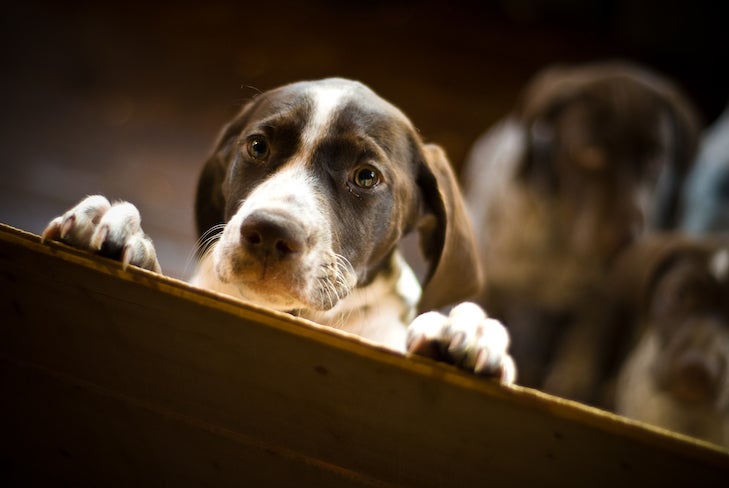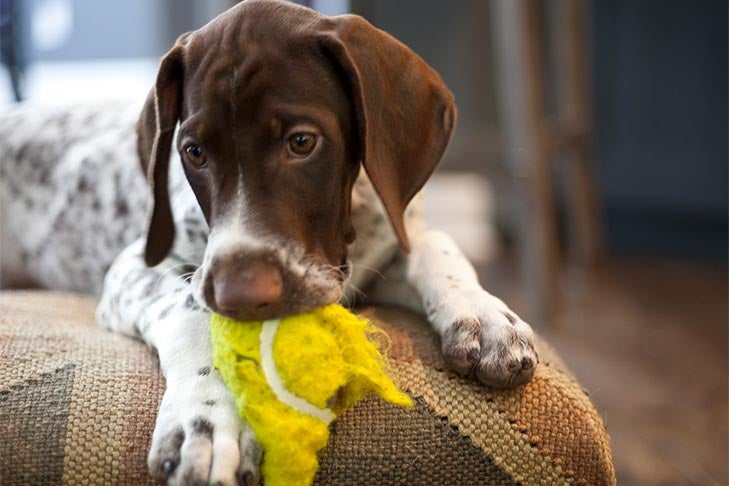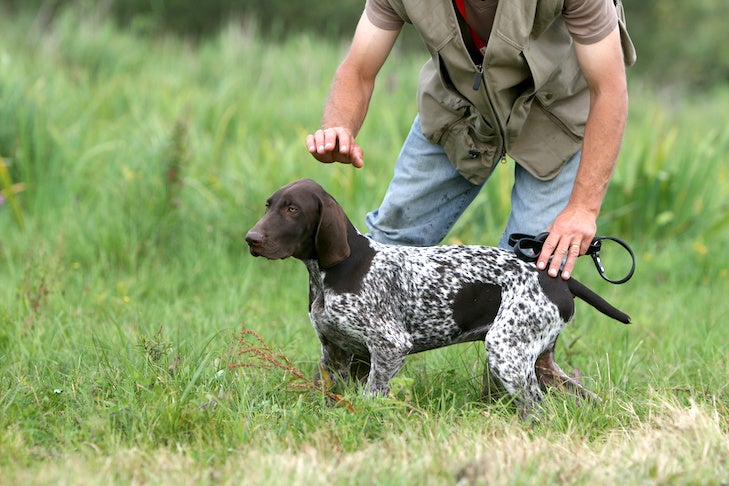German Shorthaired Pointers (GSP) are full of energy, need lots of exercise, and “can be extremely challenging from six months to three years old,” according to the AKC breed description. The good news: they’re also highly receptive to training and picking up early obedience commands.
And that’s why learning to train your GSP will be an important part of welcoming your new dog into your home.
We asked the German Shorthaired Pointer Club of America about who to speak to for expert advice on training a GSP puppy. They recommended none other than Belinda Venner, whose dog is now the top-ranked GSP for obedience, as well as multi-titled in hunt tests, conformation, and agility. Starting in 2010, she’s now had three top-ranked competitive German Pointer dogs.
Here are the key milestones Venner says to anticipate when considering getting a GSP puppy—and how you can prepare for them.
Key Milestones: 8–9 Weeks
Be prepared for a lot of firsts, starting off right when you bring your GSP home.
1. Welcome your GSP into your home.
Between eight to nine weeks is a “good age” to welcome a GSP into your family, says Venner.
2. Socialize your GSP puppy with other people.
Any time after your GSP puppy becomes part of your pack is a good time to start introducing them to other people.
Take them to meet friends, to a dog store, or any public place where they can meet people, recommends Venner.
But be sure to have people approach your dog in a way that won’t intimidate your GSP. Have your friends or strangers who want to meet your puppy bend down low and wait for the dog to make the first move.
“One good reason for that is that puppies go through fear stages at different times, and you don’t necessarily know when that’s going to happen,” Venner explains.

3. Get your dog used to grooming.
The good news is, as their name suggests, there’s little you will have to do to groom your Shorthaired Pointer. Plan on bathing your GSP as little as once a month or as needed. Otherwise, the biggest upkeep will be taking care of their nails.
“Start clipping their nails right when they come home,” says Venner. “Making it positive makes a huge difference.”
Use lots of treats and only trim one nail, one day at a time, she adds.
4. Introduce the basic commands.
“When you bring a shorthaired home, you should start training them right away,” says Venner. “They’re really, really smart. Whether it’s hunting, obedience, or agility, they can do anything,”
Start by teaching your GSP the following basic commands:
- Name recognition
- Sit
- Down
- Leave it
- Go in the kennel or crate
Try name recognition first, which they should pick up right away as long as you use your dog’s name every chance you get. “You should be calling them all the time. Call them. Give them a treat. That’s the best,” says Venner.
To get your dog to go into the kennel or crate, throw a treat inside, make sure your GSP sees it, say their name, and have them go inside.
Work on all of these basic commands daily, in short five-minute bursts throughout the day. With plenty of practice and positive reinforcement (with treats and praise), your puppy should learn them within a few weeks.

5. Get started with potty training.
Place your dog’s crate next to your bed so you can get into the habit of taking your GSP out in the middle of the night when they wake up and have to go to the bathroom. Keep things short: Make sure your dog goes potty then goes right back into the crate and goes back to sleep. This shouldn’t become a waking, playtime activity.
Throughout the rest of the day, be sure to take your puppy outside multiple times: first thing in the morning, immediately after naptime, and after eating.
6. Teach your GSP to walk on a leash.
Get started with this training milestone right away. Otherwise, the bigger your GSP grows, the bigger the challenge for you. When these dogs get bigger, they get stronger and will start pulling on their leashes.
Just remember: At the puppy stage, it’s your job to pay attention and see how far your GSP can go. It doesn’t take a lot to wear a puppy out.
Key Milestones: 12–14 Weeks
In addition to keeping up with activities you’ve started in weeks eight to nine, here are some firsts you can expect around 12 to 14 weeks.
7. Socialize your GSP with other dogs.
Now that your puppy has socialized with other humans, the next step is socializing with other dogs.
“As soon as they have their second shots, probably around 12 to 14 weeks,” you can begin introducing your GSP to other dogs, says Venner.
8. Enjoy your quiet nights for a change.
Starting at 12 to 16 weeks your GSP should be able to sleep through the night and no longer need to be taken out to go potty.

Key Milestones: 4 Months
It’s time for teething, obedience training, and more.
9. Teach your dog what’s acceptable to chew (and what’s not).
Starting at around four months, GSPs begin teething.
Venner recommends being ready to redirect your dog away from chewing on the furniture and other off-limit items to teething on appropriate items like chew toys, such as Nylabones or Kongs.
10. Enroll your GSP in puppy classes.
At this age, you can find competition and household pet obedience classes as well as puppy agility classes. These will allow your dog to interact with other dogs in a controlled environment, with fewer problems likely to arise.
Whatever classes you enroll your puppy in, make sure they’re tailored to puppy participants, since your dog is still growing and GSP growth plates are not yet fused at this stage. That means you don’t want your puppy to be jumping too high.
Key Milestones: 6 Months and Beyond
GSPs go through fear stages at six months, 12, and 18 months, says Venner. Here’s what to do.
11. Be aware of your dog’s fear stages and react appropriately.
One day your outgoing dog may suddenly become shy, scared, or start hiding around strangers or at the sound of certain noises. Even if your GSP was never afraid of meeting new people or hearing unusual sounds in the past.
If this sudden onset of fear occurs, the best thing you can do for your puppy is to ignore the fear.
“Don’t cater to it. Don’t say, ‘Oh you’re OK,'” says Venner.
However, if a stranger comes up and your dog is still afraid, it’s also appropriate to remove your GSP from the situation.
Fear stages won’t last forever and will go away on their own.
Don’t miss crucial information when it comes to raising your puppy. Get personalized training, nutritional, veterinary, and everyday advice sent straight to your inbox. Subscribe to Pupdate, a weekly email newsletter with customized content based on your puppy’s breed and age.

